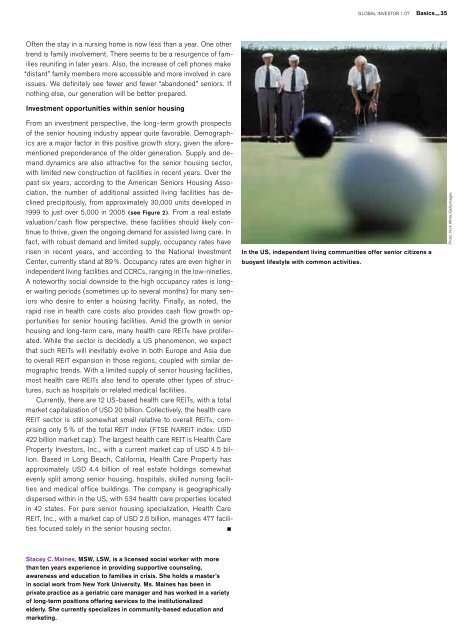Global families
Managing risks around cycles and supercycles Global Investor, 01/2007
Managing risks around cycles and supercycles
Global Investor, 01/2007
Create successful ePaper yourself
Turn your PDF publications into a flip-book with our unique Google optimized e-Paper software.
GLOBAL INVESTOR 1.07 Basics — 35<br />
Often the stay in a nursing home is now less than a year. One other<br />
trend is family involvement. There seems to be a resurgence of <strong>families</strong><br />
reuniting in later years. Also, the increase of cell phones make<br />
“distant” family members more accessible and more involved in care<br />
issues. We definitely see fewer and fewer “abandoned” seniors. If<br />
nothing else, our generation will be better prepared.<br />
Investment opportunities within senior housing<br />
From an investment perspective, the long-term growth prospects<br />
of the senior housing industry appear quite favorable. Demographics<br />
are a major factor in this positive growth story, given the aforementioned<br />
preponderance of the older generation. Supply and demand<br />
dynamics are also attractive for the senior housing sector,<br />
with limited new construction of facilities in recent years. Over the<br />
past six years, according to the American Seniors Housing Association,<br />
the number of additional assisted living facilities has declined<br />
precipitously, from approximately 30,000 units developed in<br />
1999 to just over 5,000 in 2005 (see Figure 2). From a real estate<br />
valuation / cash flow perspective, these facilities should likely continue<br />
to thrive, given the ongoing demand for assisted living care. In<br />
fact, with robust demand and limited supply, occupancy rates have<br />
risen in recent years, and according to the National Investment<br />
Center, currently stand at 89 %. Occupancy rates are even higher in<br />
independent living facilities and CCRCs, ranging in the low-nineties.<br />
A noteworthy social downside to the high occupancy rates is longer<br />
waiting periods (sometimes up to several months) for many seniors<br />
who desire to enter a housing facility. Finally, as noted, the<br />
rapid rise in health care costs also provides cash flow growth opportunities<br />
for senior housing facilities. Amid the growth in senior<br />
housing and long-term care, many health care REITs have proliferated.<br />
While the sector is decidedly a US phenomenon, we expect<br />
that such REITs will inevitably evolve in both Europe and Asia due<br />
to overall REIT expansion in those regions, coupled with similar demographic<br />
trends. With a limited supply of senior housing facilities,<br />
most health care REITs also tend to operate other types of structures,<br />
such as hospitals or related medical facilities.<br />
Currently, there are 12 US-based health care REITs, with a total<br />
market capitalization of USD 20 billion. Collectively, the health care<br />
REIT sector is still somewhat small relative to overall REITs, comprising<br />
only 5 % of the total REIT index (FTSE NAREIT index: USD<br />
422 billion market cap). The largest health care REIT is Health Care<br />
Property Investors, Inc., with a current market cap of USD 4.5 billion.<br />
Based in Long Beach, California, Health Care Property has<br />
approximately USD 4.4 billion of real estate holdings somewhat<br />
evenly split among senior housing, hospitals, skilled nursing facilities<br />
and medical office buildings. The company is geographically<br />
dispersed within in the US, with 534 health care properties located<br />
in 42 states. For pure senior housing specialization, Health Care<br />
REIT, Inc., with a market cap of USD 2.6 billion, manages 477 facilities<br />
focused solely in the senior housing sector.<br />
<br />
In the US, independent living communities offer senior citizens a<br />
buoyant lifestyle with common activities.<br />
Photo: Nick White/Gettyimages<br />
Stacey C. Maines, MSW, LSW, is a licensed social worker with more<br />
than ten years experience in providing supportive counseling,<br />
awareness and education to <strong>families</strong> in crisis. She holds a master’s<br />
in social work from New York University. Ms. Maines has been in<br />
private practice as a geriatric care manager and has worked in a variety<br />
of long-term positions offering services to the institutionalized<br />
elderly. She currently specializes in community-based education and<br />
marketing.

















